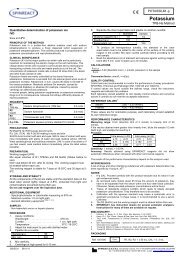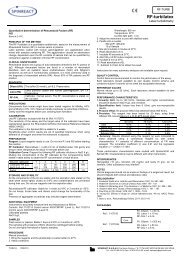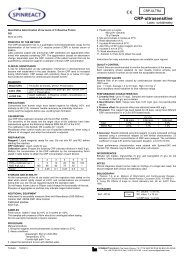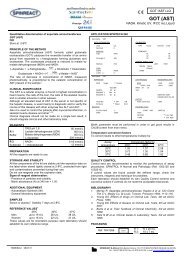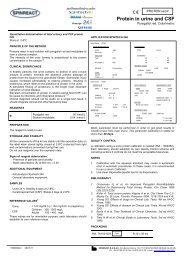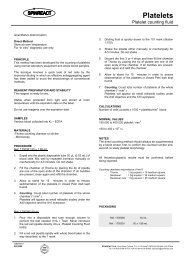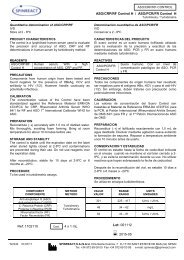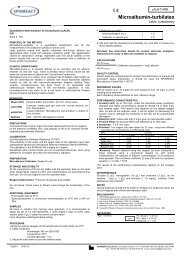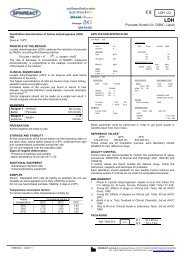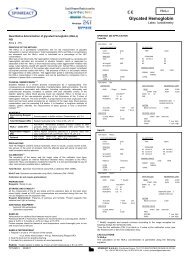SODIUM
SODIUM - Spinreact
SODIUM - Spinreact
You also want an ePaper? Increase the reach of your titles
YUMPU automatically turns print PDFs into web optimized ePapers that Google loves.
Quantitative determination of Sodium<br />
IVD<br />
Store at 2-8ºC<br />
INTENDED USE<br />
For the quantitative in vitro determination of Sodium in serum and<br />
plasma.<br />
PRINCIPLE OF THE METHOD (1)<br />
Sodium is determined enzymatically via sodium dependent -<br />
galactosidase activity with ONPG as substrate. The absorbance<br />
at 405 nm of the product O-nitrophenyl is proportional to the<br />
sodium concentration.<br />
ONPG<br />
Na+<br />
o-nitrophenol + galactose<br />
-galactosidase<br />
ONPG = o-nitrophenyl - -D-galactopyranose<br />
CLINICAL SIGNIFICANCE<br />
Sodium measurements are used in the diagnosis and treatment of<br />
aldosteronism, diabetes insipidus, adrenal hyper-tension,<br />
Addison’s disease, dehydration, inappropriate antidiuretic<br />
hormone secretion, or other diseases involving electrolyte<br />
imbalance.<br />
REAGENTS<br />
R 1<br />
Buffer /<br />
Enzymes<br />
R2<br />
Diluent /<br />
Substrate<br />
Tris buffer, pH 9.0<br />
Cryptand<br />
-galactosidase<br />
Tris buffer<br />
O-nitrophenyl galactoside<br />
450 mmol/l<br />
5.4 mmol/l<br />
0.8 U/ml<br />
10.0 mmol/l<br />
5.5 mmol/l<br />
PREPARATION<br />
R1. Buffer/Enzymes<br />
Transfer the contents of one bottle Buffer R1a to one bottle<br />
Enzyme R1b and dissolve by swirling gently, ensuring that the<br />
entire contents are completely dissolved. Transfer the entire<br />
contents to Buffer R1a rinsing vial R1b several times. Avoid the<br />
formation of foam.<br />
R2. Diluent/Substrate<br />
Transfer the contents of one bottle Diluent R2a to one bottle<br />
Substrate R2b and dissolve by swirling gently, ensuring that the<br />
entire contents are completely dissolved . Transfer the entire<br />
contents to Diluent R2a rinsing vial R2b several times. Avoid the<br />
formation of foam.<br />
STORAGE AND STABILITY<br />
R1 is stable for 2 weeks at 2-8 C or 5 days at 15-25 C.<br />
R2 is stable for 4 weeks at 2-8 C or 2 weeks at 15-25 C.<br />
Do not use reagents over the expiration date.<br />
ADDITIONAL EQUIPMENT<br />
- Spectrophotometer or colorimeter measuring at 405 nm.<br />
- Matched cuvettes 1.0 cm light path.<br />
- General laboratory equipment (Note 1) .<br />
SAMPLES<br />
Serum, plasma treated with lithium heparinate.<br />
PROCEDURE<br />
1. Assay conditions:<br />
Wavelength: . . . . . . . . . . . . . . . . . . . . . . . . . . . 405nm<br />
Cuvette: . . . . . . . . . . . . . . . . . . . . .. . . . 1 cm light path<br />
Constant temperature . . . . . . . . . . . . . . . 37ºC / 15-25ºC<br />
2. Adjust the instrument to zero with distilled water.<br />
3. Pipette into a cuvette:<br />
Standard Sample<br />
R1 720 μL 720 μL<br />
R2 290 μL 290 μL<br />
Standard 30 μL ----<br />
Sample ---- 30 μL<br />
<strong>SODIUM</strong>-d<br />
<strong>SODIUM</strong><br />
Enzymatic. Colorimetric<br />
4. Mix and read the absorbance after 60 s (A 1) and 120 s (A 2).<br />
5. Calculate: A= A 2 – A 1.<br />
CALCULATIONS<br />
( A)Sample<br />
x Calibrator conc = mmol/L sodium in the sample<br />
( A)Calibrator<br />
QUALITY CONTROL<br />
Control Sera are recommended to monitor the performance of assay<br />
procedures: SPINTROL H Normal and Pathologic (Ref. 1002120 and<br />
1002210).<br />
If control values are found outside the defined range, check the instrument,<br />
reagent and calibration for problems.<br />
Each laboratory should establish its own Quality Control scheme and<br />
corrective actions if controls do not meet the acceptable tolerances.<br />
REFERENCE VALUES (2)<br />
136 - 146 mmol/l (313 - 336 mg/dl)<br />
These values are for orientation purpose; each laboratory should<br />
establish its own reference range.<br />
PERFORMANCE CHARACTERISTICS<br />
Linearity: The method is linear between sodium concentrations of 37.3<br />
and 187.8 mmol/L<br />
Sensitivity: The minimum detectable concentration of sodium with an<br />
acceptable level of precision was determined as 37.3 mmol/l.<br />
Precision:<br />
Intra-assay (n=20) Inter-assay (n=20)<br />
Mean (mmol/L) 47.4 124.9 179.8 62.9 125.2 159.6<br />
SD 0.76 1.54 1.08 4.99 2.51 1.94<br />
CV (%) 1.60 1.23 0.60 7.94 2.01 1.21<br />
Accuracy: Results obtained using SPINREACT reagents (y) did not<br />
show systematic differences when compared with other commercial<br />
reagent (x).<br />
The results obtained using 40 samples spanning the range 119 to 226<br />
mmol/L were the following:<br />
Correlation coefficient (r): 0.98.<br />
Regression equation: y= 1.12x - 13<br />
The results of the performance characteristics depend on the analyzer<br />
used.<br />
NOTES<br />
1. In order to avoid contamination it is recommended to use<br />
disposable material.<br />
2. SPINREACT has instruction sheets for several automatic<br />
analyzers. Instructions for many of them are available on<br />
request.<br />
BIBLIOGRAPHY<br />
1. Berry, M. N. et al., (1988) Clin. Chem. 34,2295.<br />
2. Tietz, N. W. (1983) Clinical guide to Laboratory Tests, p.384, W.B.<br />
Saunders Co., Philadelphia.<br />
PACKAGING<br />
Ref: 1001385<br />
Cont.<br />
R1a, R1b (Lyo.): 3 x 20 mL,<br />
R2a, R2b (Lyo.): 3 x 9 mL<br />
BSIS81-I 04/01/12 SPINREACT,S.A./S.A.U. Ctra.Santa Coloma, 7 E-17176 SANT ESTEVE DE BAS (GI) SPAIN<br />
Tel. +34 972 69 08 00 Fax +34 972 69 00 99. e-mail: spinreact@spinreact.com
Determinación cuantitativa de Sodio<br />
IVD<br />
Conservar a 2-8ºC<br />
USO PREVISTO<br />
Para determinación cuantitativa in vitro de Sodio en suero y<br />
plasma.<br />
PRINCIPIO DEL METODO (1)<br />
El Sodio se determina enzimáticamente a través de la actividad<br />
de -galactosidasa, usando como sustrato ONPG. La<br />
absorbancia del producto o-nitrofenil a 405 nm es porporcional a<br />
la concentración de sodio.<br />
ONPG<br />
Na+<br />
o-nitrofenol + galactosa<br />
-galactosidasa<br />
ONPG = o-nitrofenil - -D-galactopiranosa<br />
SIGNIFICADO CLINICO<br />
Este test se utiliza en el diagnóstico y tratamiento de<br />
hiperaldosteronismo, diabetes insípida, hiper-tensión suprarrenal,<br />
enfermedad de Addison, deshidratación, secreción inadecuada<br />
de hormona antidiurética, o de otras enfermedades de<br />
desequilibrio electrolítico<br />
REACTIVOS<br />
R 1<br />
Tampón /<br />
Enzimas<br />
R2<br />
Diluyente/<br />
Sustrato<br />
TampónTris, pH 9.0<br />
Cryptand<br />
-galactosidasa<br />
TampónTris<br />
O-nitrofenil galactosida<br />
450 mmol/l<br />
5.4 mmol/l<br />
0.8 U/ml<br />
10.0 mmol/l<br />
5.5 mmol/l<br />
PREPARACION<br />
R1. Tampón / Enzimas<br />
Transferir el contenido de 1 vial de Tampón R1a a un vial de<br />
Enzima R1b agitando ligeramente, asegurándose que todo el<br />
contenido se disuelve completamente. Transferir el contenido<br />
total al tampón R1a, lavando el vial R1b varias veces. Evitar la<br />
formación de espuma.<br />
R2. Diluyente/ Sustrato<br />
Transferir el contenido de 1 vial de Diluyente R2a a un vial de<br />
Sustrato R2b agitando ligeramente, asegurándose que todo el<br />
contenido se disuelve completamente. Transferir el contenido<br />
total al tampón R2a, lavando el vial R2b varias veces. Evitar la<br />
formación de espuma.<br />
CONSERVACION Y ESTABILIDAD<br />
R1 es estable 2 semanas a 2-8ºC o 5 días a 15-25ºC.<br />
R2 es estable 4 semanas a 2-8ºC o 2 semanas a 15-25ºC.<br />
No usar los reactivos una vez pasada la fecha de<br />
caducidad.<br />
MATERIAL ADICIONAL<br />
- Espectrofotómetro o analizador para lecturas a 405 nm.<br />
- Cubetas de 1,0 cm de paso de luz.<br />
- Equipamiento habitual de laboratorio (Nota 1) .<br />
MUESTRAS<br />
Suero, plasma tratado con heparinato de litio.<br />
PROCEDIMIENTO<br />
1. Condiciones del ensayo:<br />
Longitud de onda: . . . . . . . . . . . . . . . . . . . . . . .. . . . 405 nm<br />
Cubeta:. . . . . . . . . . . . . . . . . . . . . . . . .. . . . .1 cm paso de luz<br />
Temperatura constante . . . . . . . . . . . . . . . . . . .37ºC / 15-25ºC<br />
<strong>SODIUM</strong>-d<br />
SODIO<br />
Enzimático. Colorimétrico<br />
2. Ajustar el espectrofotómetro a cero frente a agua destilada.<br />
3. Pipetear en la cubeta:<br />
Estándar Muestra<br />
R1 720 μL 720 μL<br />
R2 290 μL 290 μL<br />
Estándar 30 μL ----<br />
Muestra ---- 30 μL<br />
4. Mezclar y leer la absorbancia después de 60 s (A1) y 120 s (A2).<br />
5. Calcular: A= A 2 – A 1.<br />
CALCULOS<br />
( A)<br />
Muestra x Conc Calibrador = mmol/L sodio en la muestra<br />
( A)<br />
Calibrador<br />
CONTROL DE CALIDAD<br />
Es conveniente analizar junto con las muestras sueros control<br />
valorados:<br />
SPINTROL H Normal y Patológico (Ref. 1002120 and 1002210). Si los<br />
valores hallados se encuentran fuera del rango de tolerancia, se debe<br />
revisar el instrumento, los reactivos y la técnica.<br />
Cada laboratorio debe disponer su propio Control de Calidad y<br />
establecer correcciones en el caso de que los controles no cumplan<br />
con las tolerancias.<br />
VALORES DE REFERENCIA (2)<br />
136 - 146 mmol/l (313 - 336 mg/dl)<br />
Estos valores son orientativos. Es recomendable que cada laboratorio<br />
establezca sus propios valores de referencia.<br />
CARACTERISTICAS DEL METODO<br />
Linealidad: El método es lineal entre concentraciones de sodio de<br />
37.3 y 187.8 mmol/L<br />
Sensibilidad: La mínima concentración de sodio detectable con un<br />
nivel de precisión aceptable se determinó a 37.3 mmol/l.<br />
Precisión:<br />
Intraserie (n=20) Interserie(n=20)<br />
Media (mmol/L) 47.4 124.9 179.8 62.9 125.2 159.6<br />
SD 0.76 1.54 1.08 4.99 2.51 1.94<br />
CV (%) 1.60 1.23 0.60 7.94 2.01 1.21<br />
Exactitud: Los reactivos SPINREACT (y) no muestran diferencias<br />
sistemáticas significativas cuando se comparan con otros reactivos<br />
comerciales (x).<br />
Los resultados obtenidos con 40 muestras entre 119 y 226 fueron los<br />
siguientes:<br />
Coeficiente de regresión (r): 0.98<br />
Ecuación de la recta de regresión: y= 1.12x – 13<br />
Las características del método pueden variar según el analizador<br />
utilizado.<br />
NOTAS<br />
1. A fin de evitar contaminaciones se recomienda utilizar material de<br />
plástico de un solo uso.<br />
2. SPINREACT dispone de instrucciones detalladas para la<br />
aplicación de este reactivo en distintos analizadores.<br />
BIBLIOGRAFIA<br />
1. Berry, M. N. et al., (1988) Clin. Chem. 34,2295.<br />
2. Tietz, N. W. (1983) Clinical guide to Laboratory Tests, p.384, W.B.<br />
Saunders Co., Philadelphia.<br />
PRESENTACION<br />
Ref: 1001385<br />
Cont.<br />
R1a, R1b (Lio.): 3 x 20 mL,<br />
R2a, R2b (Lio.): 3 x 9 mL<br />
BSIS83-E 04/01/12 SPINREACT,S.A./S.A.U. Ctra.Santa Coloma, 7 E-17176 SANT ESTEVE DE BAS (GI) SPAIN<br />
Tel. +34 972 69 08 00 Fax +34 972 69 00 99. e-mail: spinreact@spinreact.com



